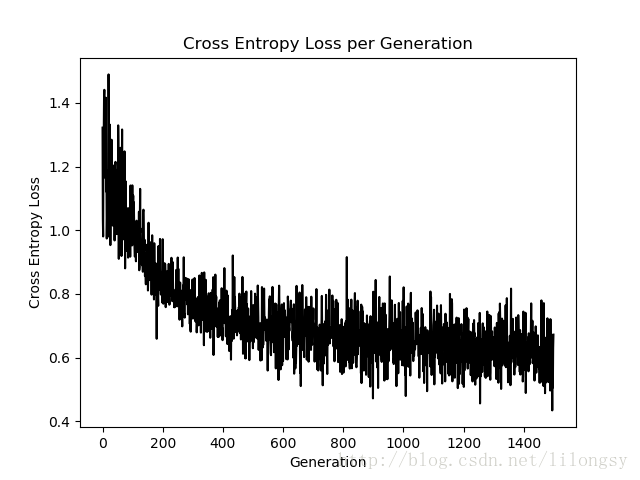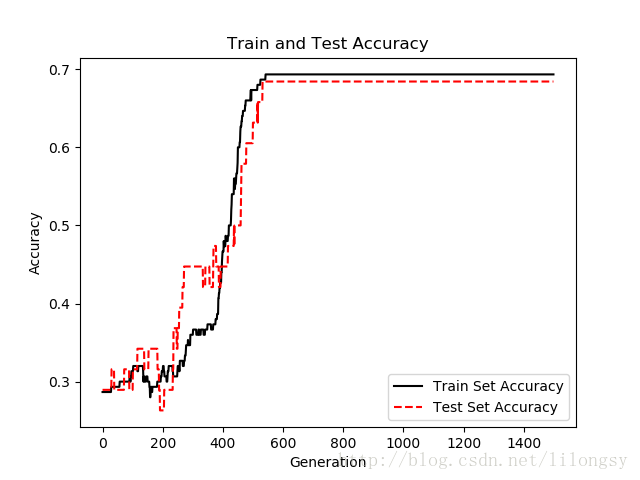|
1
2
3
4
5
6
7
8
9
10
11
12
13
14
15
16
17
18
19
20
21
22
23
24
25
26
27
28
29
30
31
32
33
34
35
36
37
38
39
40
41
42
43
44
45
46
47
48
49
50
51
52
53
54
55
56
57
58
59
60
61
62
63
64
65
66
67
68
69
70
71
72
73
74
75
76
77
78
79
80
81
82
83
84
85
86
87
88
89
90
91
92
93
94
95
96
97
98
99
100
101
102
103
104
105
106
107
108
109
110
111
112
113
114
115
116
117
118
119
120
121
122
123
124
125
126
127
128
129
130
131
132
133
134
135
136
137
138
139
140
141
142
143
144
145
146
147
148
149
150
151
152
153
154
155
156
157
158
159
160
161
162
163
164
165
166
|
# Logistic Regression# 逻辑回归#----------------------------------## This function shows how to use TensorFlow to# solve logistic regression.# y = sigmoid(Ax + b)## We will use the low birth weight data, specifically:# y = 0 or 1 = low birth weight# x = demographic and medical history dataimport matplotlib.pyplot as pltimport numpy as npimport tensorflow as tfimport requestsfrom tensorflow.python.framework import opsimport os.pathimport csvops.reset_default_graph()# Create graphsess = tf.Session()#### Obtain and prepare data for modeling#### name of data filebirth_weight_file = 'birth_weight.csv'# download data and create data file if file does not exist in current directoryif not os.path.exists(birth_weight_file): birthdata_url = 'https://github.com/nfmcclure/tensorflow_cookbook/raw/master/01_Introduction/07_Working_with_Data_Sources/birthweight_data/birthweight.dat' birth_file = requests.get(birthdata_url) birth_data = birth_file.text.split('\r\n') birth_header = birth_data[0].split('\t') birth_data = [[float(x) for x in y.split('\t') if len(x)>=1] for y in birth_data[1:] if len(y)>=1] with open(birth_weight_file, "w") as f: writer = csv.writer(f) writer.writerow(birth_header) writer.writerows(birth_data) f.close()# read birth weight data into memorybirth_data = []with open(birth_weight_file, newline='') as csvfile: csv_reader = csv.reader(csvfile) birth_header = next(csv_reader) for row in csv_reader: birth_data.append(row)birth_data = [[float(x) for x in row] for row in birth_data]# Pull out target variabley_vals = np.array([x[0] for x in birth_data])# Pull out predictor variables (not id, not target, and not birthweight)x_vals = np.array([x[1:8] for x in birth_data])# set for reproducible resultsseed = 99np.random.seed(seed)tf.set_random_seed(seed)# Split data into train/test = 80%/20%# 分割数据集为测试集和训练集train_indices = np.random.choice(len(x_vals), round(len(x_vals)*0.8), replace=False)test_indices = np.array(list(set(range(len(x_vals))) - set(train_indices)))x_vals_train = x_vals[train_indices]x_vals_test = x_vals[test_indices]y_vals_train = y_vals[train_indices]y_vals_test = y_vals[test_indices]# Normalize by column (min-max norm)# 将所有特征缩放到0和1区间(min-max缩放),逻辑回归收敛的效果更好# 归一化特征def normalize_cols(m): col_max = m.max(axis=0) col_min = m.min(axis=0) return (m-col_min) / (col_max - col_min)x_vals_train = np.nan_to_num(normalize_cols(x_vals_train))x_vals_test = np.nan_to_num(normalize_cols(x_vals_test))#### Define Tensorflow computational graph¶#### Declare batch sizebatch_size = 25# Initialize placeholdersx_data = tf.placeholder(shape=[None, 7], dtype=tf.float32)y_target = tf.placeholder(shape=[None, 1], dtype=tf.float32)# Create variables for linear regressionA = tf.Variable(tf.random_normal(shape=[7,1]))b = tf.Variable(tf.random_normal(shape=[1,1]))# Declare model operationsmodel_output = tf.add(tf.matmul(x_data, A), b)# Declare loss function (Cross Entropy loss)loss = tf.reduce_mean(tf.nn.sigmoid_cross_entropy_with_logits(logits=model_output, labels=y_target))# Declare optimizermy_opt = tf.train.GradientDescentOptimizer(0.01)train_step = my_opt.minimize(loss)#### Train model#### Initialize variablesinit = tf.global_variables_initializer()sess.run(init)# Actual Prediction# 除记录损失函数外,也需要记录分类器在训练集和测试集上的准确度。# 所以创建一个返回准确度的预测函数prediction = tf.round(tf.sigmoid(model_output))predictions_correct = tf.cast(tf.equal(prediction, y_target), tf.float32)accuracy = tf.reduce_mean(predictions_correct)# Training loop# 开始遍历迭代训练,记录损失值和准确度loss_vec = []train_acc = []test_acc = []for i in range(1500): rand_index = np.random.choice(len(x_vals_train), size=batch_size) rand_x = x_vals_train[rand_index] rand_y = np.transpose([y_vals_train[rand_index]]) sess.run(train_step, feed_dict={x_data: rand_x, y_target: rand_y}) temp_loss = sess.run(loss, feed_dict={x_data: rand_x, y_target: rand_y}) loss_vec.append(temp_loss) temp_acc_train = sess.run(accuracy, feed_dict={x_data: x_vals_train, y_target: np.transpose([y_vals_train])}) train_acc.append(temp_acc_train) temp_acc_test = sess.run(accuracy, feed_dict={x_data: x_vals_test, y_target: np.transpose([y_vals_test])}) test_acc.append(temp_acc_test) if (i+1)%300==0: print('Loss = ' + str(temp_loss))#### Display model performance#### 绘制损失和准确度plt.plot(loss_vec, 'k-')plt.title('Cross Entropy Loss per Generation')plt.xlabel('Generation')plt.ylabel('Cross Entropy Loss')plt.show()# Plot train and test accuracyplt.plot(train_acc, 'k-', label='Train Set Accuracy')plt.plot(test_acc, 'r--', label='Test Set Accuracy')plt.title('Train and Test Accuracy')plt.xlabel('Generation')plt.ylabel('Accuracy')plt.legend(loc='lower right')plt.show() |
数据结果:
Loss = 0.845124
Loss = 0.658061
Loss = 0.471852
Loss = 0.643469
Loss = 0.672077

迭代1500次的交叉熵损失图

迭代1500次的测试集和训练集的准确度图
以上就是本文的全部内容,希望对大家的学习有所帮助,也希望大家多多支持服务器之家。
原文链接:https://blog.csdn.net/lilongsy/article/details/79364678










